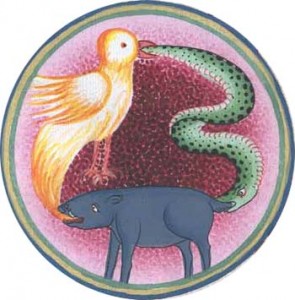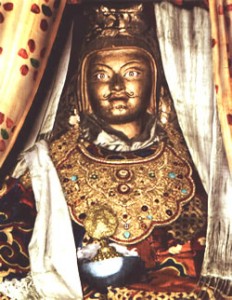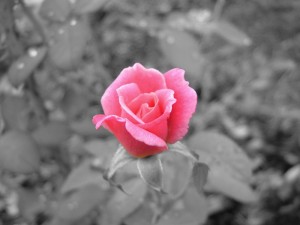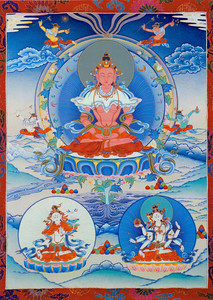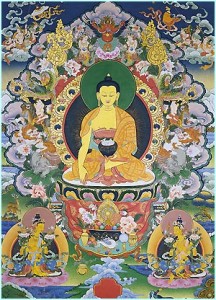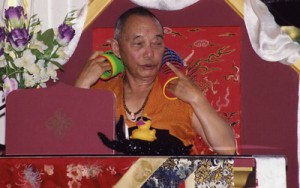
An excerpt from the Mindfulness workshop given by Jetsunma Ahkon Lhamo in 1999
The mistake that we make with almost any spiritual practice is waiting for it to affect us. We’re waiting for the “feeling” when Dharma is supposed to sweep us away like a Calgon bath or something, and that’s not the way it’s ever going to happen. You may have wonderful, sweeping experiences, but you’ll do that in your bathtub too. It’s just normal.
The kinds of practices that we are taught to do on the Vajrayana path, such as prostrations, are quite different and unique for us and for our culture. At first, a Westerner feels very strange performing prostrations. We feel goofy and foolish and think, “Wait a minute! I don’t even know if I like her yet. I mean, just because she’s on the big chair…” But that’s exactly why we do the prostrations, because she’s on the big chair. The big chair is there because the big chair is the throne of Dharma. It’s not my throne. It’s not Alyce Zeoli’s throne. It’s not Ahkön Lhamo’s throne. It is the throne of Dharma. When we perform the prostrations that we do, it is actually meant to be a connection between body, speech, and mind. These three are utilized together. The physical is doing something, the speech is doing something, and hopefully the mind is doing something. These three aspects of ourselves performing at the same time makes a sense of connection. It is a ritual that anchors something that is subtle, very spiritual: you can’t taste it, you can’t own it, you can’t pick it up. It anchors it into the physical. When the body performs the prostrations, you literally go into a different space. That event involving body, speech and mind takes you into a different space, if all three are engaged.
There are many mannerisms associated with Dharma, and as Westerners we think, “Well, I don’t get that whole crouching over thing. It just looks like a hunchback to me.” As Westerners, we’re taught to walk straight, almost military-like and prideful. But, actually, it is the constant mindfulness when you are in the presence of the Lama that creates an exchange of some sort. It’s not that you have to be unnatural all the time. If there is an exchange of some sort, simply that subtle tendency of doing that very little bow with mindfulness – and that’s the trick – puts the Lama’s speech in a place where you can hear it more directly. It actually establishes the connection between you and the teacher, almost like a tube or a direct tunnel going between yourself and the teacher. If you were in a room full of people and your Root Guru was talking and other people were talking and you were listening to everybody at the same time and to all in the same way, there would be no blessing there. The reason why there would be no blessing is because the main point of practicing Guru Yoga is to get us past the point of pridefulness and past the point of lack of discrimination that makes us not know whether something is extraordinary or simply ordinary. Eventually, we will come to see the non-duality of the nature of the Lama and one’s own nature. At that point one actually takes refuge in that nature, which is one’s own nature every bit as much as it is the Lama’s nature. Until then, this training is actually mind training, and, once again, Westerners have a hard time with that. We keep trying to slip it off, because we’re naturally uncomfortable with it. It doesn’t look like the rest of our culture, and we truly don’t understand.
We try to take our clues from the Lama, and this is where we all go wrong because some Lamas, like Gyaltrul Rinpoche, are funky, humble guys, and other Lamas come in like they’re your best friend. And then other Lamas come in, and they have a very fine and royal, genteel appearance. There are so many different Lamas. The trick is not to take your clue from the Lama, but to take your clue from the Dharma: from the teachings about the nature of the Lama. Whatever the appearance is, you need to form the habitual tendency and mindfulness of elevating that in preparation for the recognition of and awakening to your own Buddhanature. The reason why we’re asleep, why we’re not able to awaken, as the Buddha is awake, is primarily because the mind is so thickened through the mixture of non-virtue and virtue. It’s literally coarsened to where the loudest thing is what we hear, and the loudest thing is our ego. The loudest voice is our demand, our desire, how we feel, whether our feet hurt or not. That’s the loudest voice. The mind is simply not able to distinguish through the obscuration of being constantly involved in clinging to self-nature as inherently real. So the practice of Guru Yoga is for you, not for the teacher. Actually, I have found it to be very inconvenient. To get across the room when people are trying to prostrate is very difficult. I really do come from Brooklyn, and I really don’t care about that stuff. The only reason why I teach it the way I do, with such a fervent energy, is because I know how it works, and I know the power of that kind of practice.
© Jetsunma Ahkön Lhamo
